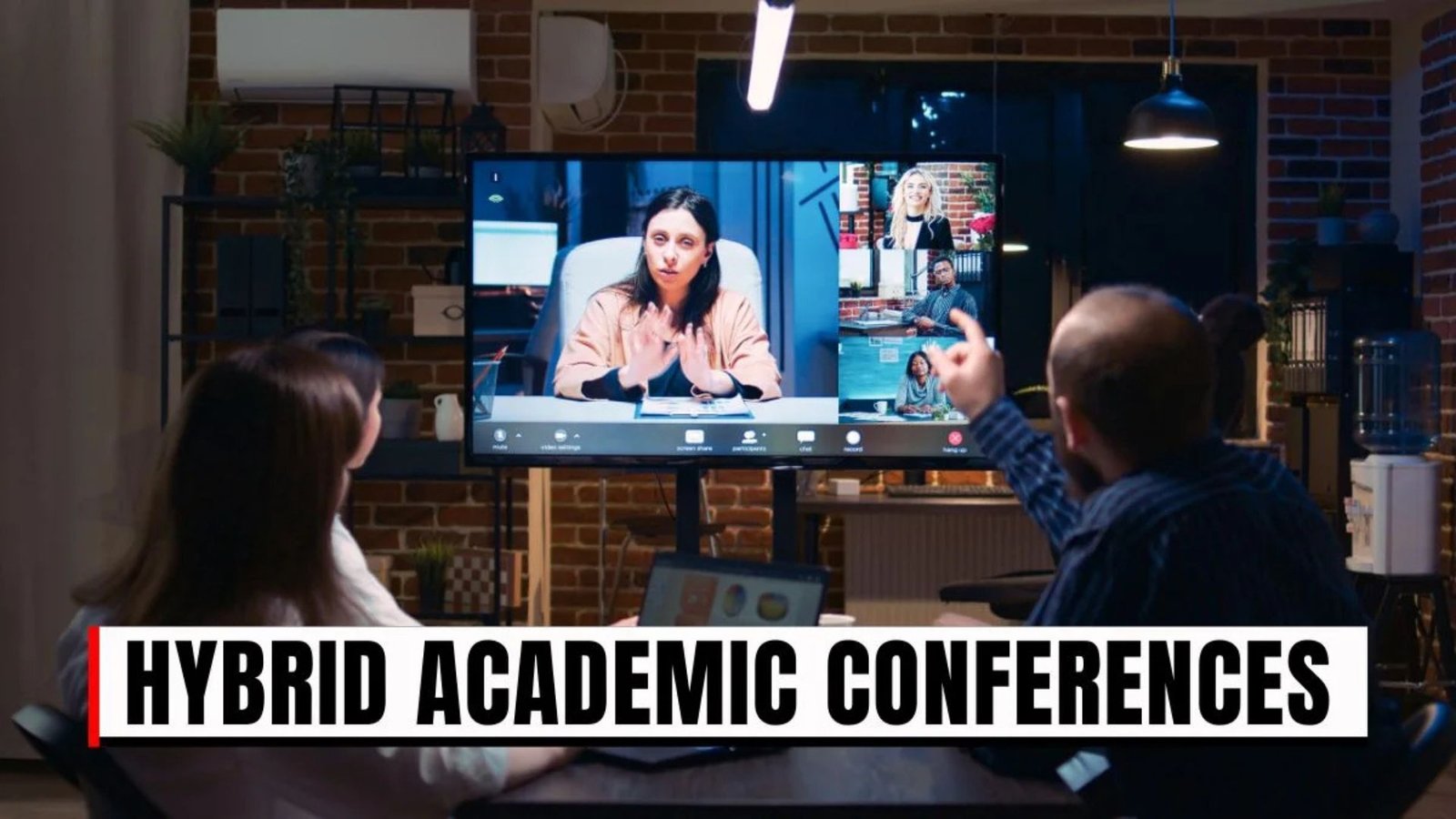Hybrid academic conferences combine the best of in-person and virtual events, offering flexibility, wider reach, and unique networking opportunities. Whether you’re a researcher, student, or professional, mastering the hybrid format can elevate your experience. This guide shares practical, easy-to-follow tips to help you make the most of both worlds, ensuring you stand out and connect effectively. Optimized for SEO, this article uses simple language, actionable advice, and a clear structure to outshine competing content.
What Are Hybrid Academic Conferences?
A hybrid academic conference blends physical and online participation. Some attendees join in person at a venue, while others connect virtually through platforms like Zoom or Microsoft Teams. This format emerged to balance accessibility, cost, and engagement, especially after the rise of virtual events during the pandemic. It allows global participation without travel barriers while preserving the value of face-to-face interactions.
Why Hybrid Academic Conferences Matter
- Wider Reach: Scholars from different countries can join without travel costs.
- Flexibility: Choose to attend in person or online based on your schedule or budget.
- Networking Opportunities: Connect with peers both locally and globally.
- Cost-Effective: Virtual attendance often costs less than in-person tickets.
- Sustainability: Reduces travel-related carbon footprints.
How to Prepare for a Hybrid Academic Conference
Preparation is key to thriving in a hybrid setting. Here’s how to get ready for both in-person and virtual participation.
1. Research the Conference Format
Understand the event’s structure. Will sessions be live-streamed, recorded, or a mix of both? Check the agenda for time zones, session formats (e.g., panels, workshops, or Q&As), and platforms used. This helps you plan your participation effectively.
Actionable Tips:
- Visit the conference website for schedules and tech requirements.
- Confirm whether virtual sessions are live or pre-recorded.
- Download required apps (e.g., Zoom, Microsoft Teams) in advance.
2. Test Your Technology
For virtual attendees, tech issues can disrupt your experience. Ensure your setup is reliable.
Actionable Tips:
- Use a stable internet connection (at least 10 Mbps for video streaming).
- Test your microphone, camera, and speakers before the event.
- Have a backup device or hotspot ready in case of technical glitches.
3. Plan Your Schedule
Hybrid academic conferences often have packed agendas. Review the program early to prioritize sessions, whether attending in person or online.
Actionable Tips:
- Mark key sessions, such as keynote speeches or workshops, in your calendar.
- Account for time zone differences if joining virtually.
- Allocate time for networking or breaks to avoid burnout.
4. Prepare Your Materials
Whether presenting or attending, have your resources ready. For presenters, this means slides, handouts, or posters. For attendees, prepare questions or notes.
Actionable Tips:
- Create clear, concise slides for virtual or in-person presentations.
- Save materials in multiple formats (e.g., PDF, PowerPoint) for compatibility.
- Practice your presentation to fit the allotted time.
Maximizing Your In-Person Experience at Hybrid Academic Conferences
In-person attendance offers unique benefits like face-to-face networking and immersive discussions. Here’s how to make the most of it.
1. Engage Actively in Sessions
In-person sessions allow for direct interaction with speakers and peers. Be proactive to stand out.
Actionable Tips:
- Ask thoughtful questions during Q&A sessions.
- Take notes to share insights with virtual attendees via social media.
- Introduce yourself to speakers after their talks.
2. Network Effectively
Networking is a highlight of in-person attendance. Build meaningful connections with peers and experts.
Actionable Tips:
- Bring business cards or digital contact info (e.g., QR codes).
- Attend social events like coffee breaks or dinners.
- Follow up with new contacts via email or LinkedIn within a week.
3. Explore the Venue
Physical venues often have exhibits, poster sessions, or informal meetups. Make time to explore these.
Actionable Tips:
- Visit poster sessions to discover new research.
- Check out sponsor booths for free resources or opportunities.
- Use venue maps to navigate efficiently.
Excelling in the Virtual Component of Hybrid Academic Conferences
Virtual participation requires a different approach but offers equal opportunities to learn and connect. Here’s how to shine online.
1. Create a Distraction-Free Environment
A focused setup enhances your virtual experience.
Actionable Tips:
- Choose a quiet, well-lit space for video calls.
- Use headphones to improve audio quality.
- Turn off notifications on your device to stay focused.
2. Engage in Virtual Sessions
Virtual platforms often have chat features, polls, or Q&A tools. Use these to stay active.
Actionable Tips:
- Post questions or comments in the chat to engage with speakers.
- Participate in polls to contribute to discussions.
- Share session insights on social media using the conference hashtag.
3. Leverage On-Demand Content
Many hybrid academic conferences offer recorded sessions. Use these to catch up on missed talks or review key points.
Actionable Tips:
- Bookmark recordings for later viewing.
- Take notes on key takeaways to reference in your work.
- Share recordings with colleagues who couldn’t attend.
Networking Across Both Worlds
Networking in a hybrid setting combines in-person and virtual strategies. Here’s how to build connections seamlessly.
1. Use Social Media and Conference Apps
Most conferences have official hashtags or apps for networking. Engage actively to connect with both in-person and virtual attendees.
Actionable Tips:
- Follow the conference’s social media accounts for updates.
- Use the event hashtag to share insights and connect with others.
- Join virtual networking rooms or forums provided by the conference.
2. Join Breakout Sessions
Hybrid events often include breakout rooms or small group discussions. These are great for deeper connections.
Actionable Tips:
- Sign up for breakout sessions aligned with your interests.
- Introduce yourself briefly in virtual rooms to make an impression.
- Exchange contact details with group members for future collaboration.
3. Follow Up Post-Conference
Building lasting relationships requires follow-up after the event.
Actionable Tips:
- Send personalized emails to new contacts within a week.
- Connect on LinkedIn with a tailored message about your meeting.
- Share resources or insights from the conference to keep the conversation going.
Key Differences Between In-Person and Virtual Attendance at Hybrid Academic Conferences
| Aspect | In-Person Attendance | Virtual Attendance |
|---|---|---|
| Cost | Higher (travel, accommodation, registration) | Lower (often just registration fees) |
| Networking | Face-to-face, more personal | Virtual, via chat or breakout rooms |
| Access to Sessions | Limited to venue schedule | Flexible, with on-demand recordings |
| Tech Requirements | Minimal (laptop or notebook) | Reliable internet, device, and software |
| Travel | Required, time-consuming | None, join from anywhere |
| Engagement Tools | Q&A, discussions, physical exhibits | Chat, polls, virtual Q&A |
Overcoming Common Challenges in Hybrid Academic Conferences
Hybrid formats can have hurdles, but with the right strategies, you can overcome them.
1. Time Zone Conflicts
Virtual attendees in different time zones may struggle with live sessions.
Solutions:
- Watch recordings of missed sessions.
- Request session summaries from organizers or peers.
- Focus on asynchronous content like forums or chats.
2. Technical Issues
Glitches can disrupt virtual participation.
Solutions:
- Test your setup days before the event.
- Have a backup internet connection (e.g., mobile hotspot).
- Contact the conference tech support team promptly.
3. Engagement Fatigue
Long sessions, whether in-person or virtual, can be exhausting.
Solutions:
- Take short breaks between sessions.
- Stay hydrated and avoid screen overload.
- Prioritize high-value sessions to stay energized.
Post-Conference Actions to Maximize Impact
Your conference experience doesn’t end when the event does. Take these steps to make lasting gains.
1. Review and Organize Notes
Consolidate your notes to retain key insights.
Actionable Tips:
- Summarize key takeaways in a document or notebook.
- Share insights with colleagues or on social media.
- Apply learnings to your research or work.
2. Publish or Share Your Work
If you presented, amplify your work post-conference.
Actionable Tips:
- Share your presentation slides on platforms like SlideShare.
- Write a blog post summarizing your talk.
- Submit your research to relevant journals or repositories.
3. Stay Connected
Maintain relationships with new contacts to build your network.
Actionable Tips:
- Join professional groups related to the conference topic.
- Collaborate on research or projects with new contacts.
- Attend future events to strengthen ties.
Why Hybrid Academic Conferences Are the Future
The hybrid model is here to stay, offering unmatched flexibility and inclusivity. By blending in-person and virtual elements, these conferences cater to diverse needs, making academic exchange more accessible. Mastering both formats ensures you stay ahead in your field, whether you’re presenting groundbreaking research or learning from global experts.




